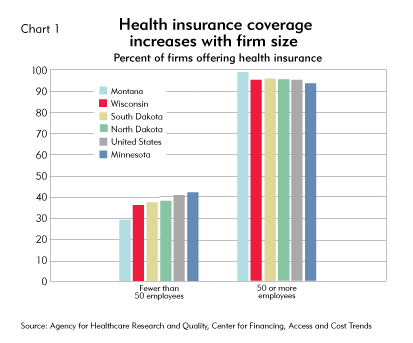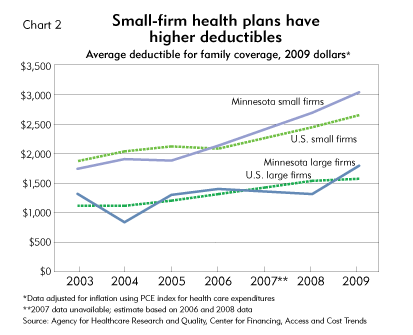D. J. Colter has witnessed firsthand the struggles of small businesses—including his own—to keep their health insurance coverage. Colter, a Fargo, N.D., American Family Insurance agent and independent broker, says his clients—mostly small firms and self-employed people in the Fargo-Moorhead area—have been hit by sharply rising premiums for small-group and individual insurance.
Since last fall, two clients have dropped health coverage for their workers because they can’t afford the premiums, he said. And last summer, Colter himself received a jolt in the mail from his insurance company: “the biggest increase I’d ever seen” in the cost of providing health coverage for him and his two full-time employees. For now, he’s keeping his agency health plan.
Chiefly because of high premiums for small groups, small firms are much less likely to sponsor employee coverage than large firms, according to surveys by the federal Agency for Healthcare Research and Quality (AHRQ; see Chart 1). In North Dakota, 96 percent of companies with 50 or more employees sponsored health coverage in 2009. In contrast, just 38 percent of firms below that threshold offered their workers some sort of health plan. In Montana, it was 28 percent. Consequently, most employees of small businesses in Montana must buy their own insurance in the individual market, or go uncovered.
Much of the reason for this disparity comes down to pricing. State laws, for example, guarantee small businesses access to coverage, but many small firms believe it is too expensive, said Bob Johnson, president of the Insurance Federation of Minnesota. “State law requires that insurers have to sell it to them, but [small firms] don’t have the money to pay for it,” he said. “The bigger, macro issue here is affordability.”
On average, small employers pay higher administrative costs than large firms, because sales, billing and other nonmedical expenses are spread over fewer workers. And adverse selection—the tendency of very small firms to buy insurance only when one or two employees are likely to need medical care—skews premiums higher for small groups. As a result, small employers typically pay more than large ones for plans with similar benefits.
Sole proprietors pay even more for health coverage. Nongroup, or individual, insurance—which covers about 6 percent of nonelderly people nationwide, but over 10 percent in Montana and the Dakotas—typically costs more than comparable small-group coverage, and rates are rising faster: A Kaiser Family Foundation survey last year found that recent rate increases for individual policies averaged 20 percent.
Survival strategies
Small businesses have waged an uphill battle to control premium increases. Self-insuring, a savings strategy popular with large and mid-size companies, isn’t practicable for firms with fewer than 100 employees—the risk pool isn’t big enough. But small businesses are trying to limit insurance costs and sustain health coverage in other ways.
To an even greater degree than large employers, small employers have responded to premium increases by requiring workers to bear a greater share of the costs of health coverage. In recent years, small firms have sponsored health plans with much higher deductibles than those chosen by large firms. In Minnesota, for example, the average 2009 deductible for family health coverage offered by firms with fewer than 50 employees was $3,026, according to AHRQ surveys of medical expenditures (see Chart 2); that’s about two-thirds higher than the average deductible figure at larger firms.
Higher deductibles have helped to keep premiums for small-firm plans in check; in fact, in 2009, the average total premium for family coverage in the United States and every district state was lower for small businesses than for large ones. Curbing premium increases in turn has enabled small employers such as the D. J. Colter Agency to maintain health coverage for workers.
After the firm’s premiums almost doubled last year, Colter “had to raise deductibles just so I could stay in the market to keep the coverage,” he said. He added that many of his clients in the Fargo area are considering switching to high-deductible policies—group or individual plans with deductibles over $1,000 that also require large co-pays for care.
Although the proportion of U.S. small firms that sponsor health insurance has fallen slightly in recent years, in the district it has dropped markedly only in Wisconsin and Montana, according to AHRQ data. But high deductibles mean that the coverage small businesses offer their workers is less comprehensive than in the past.
Some business groups—chambers of commerce, industry associations—are also creating their own insurance pools that promise members better deals on health coverage. In many states, insurers are permitted to offer associations special terms based on the claims history of the whole group rather than that of individual member firms.
The Montana Chamber of Commerce has sponsored a health insurance program for its members since 2004. Small businesses can choose among 11 major medical plans underwritten by Blue Cross and Blue Shield of Montana. Chamber officials claim that the program insulates firms to some extent from price hikes, because Blue Cross bases annual rate changes for individual firms on the claims of the entire program pool. The program also enables small firms to flex their collective buying power; the chamber negotiates on their behalf for low rates and extra benefits such as dental exams and wellness services.
Chamber President Webb Brown acknowledges that the chamber’s health coverage isn’t “a panacea” for high insurance prices—premiums are still high relative to what large firms pay. “But at the same time … there’s a benefit to being in a group rather than on your own,” he said. The program has succeeded in increasing coverage for employees in Montana; over half of the 1,500 firms in the program previously didn’t offer health coverage.
The South Dakota Retailers Association offers a similar program to its nearly 4,000 members, mostly small businesses with fewer than 50 employees. Risks are not pooled among firms covered by association health plans, but Executive Director Shawn Lyons said the organization’s purchasing power minimizes rate increases and provides enrollees with additional benefits unavailable to individual firms.
Government intervention
Government has tried to encourage small businesses to sponsor health insurance by restricting the rates that insurers can charge them. In addition to rules mandating the sale of insurance to small employers, every district state enforces rate bands designed to limit premium increases for small firms and, in some states, sole proprietors.
Rate bands determine how far rates can deviate from an “index” or average rate that insurers calculate based on their book of business. In Minnesota, for example, renewal rates cannot vary more than 25 percent above or below the index rate. This means that firms that have suffered a rash of illness over the past year pay lower premiums than they would in an unregulated market.
But it’s unclear whether such market intervention has influenced small-business sponsorship of health coverage in the district. Johnson observes that rate bands make insurance more expensive for small firms with young, healthy workforces. Restricting rates lowers premiums for “sick” firms, possibly increasing insurance offers, but those gains may be counterbalanced by healthy firms that forgo coverage because of higher premiums.
The federal health care law enacted last year contains a number of provisions intended to foster insurance coverage by small businesses. Health care exchanges, online bazaars in which small firms can compare benefits and prices, are slated to open in 2014. By 2016, states must open the exchanges to firms with up to 100 employees.
Another provision of the law already in force gives federal tax breaks to employers with fewer than 25 workers and average annual wages below $50,000 to offset the costs of providing insurance. The tax credits increase in 2014, covering half of the premium contributed by small, low-wage employers that buy insurance through exchanges. However, one insurance industry observer questioned whether the tax breaks are sufficient to significantly increase the proportion of small employers offering health coverage.
The same could be said of current efforts, both public and private, to increase small firms’ participation in the health insurance market. For the foreseeable future, the yawning gap between offers of health coverage by small versus large employers is likely to persist.







